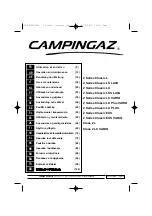
18
CARE AND CLEANING OF STAINLESS STEEL
Stainless steel parts of this appliance are made from 304
grade stainless steel. To preserve the appearance and cor
-
rosion resistance of the stainless steel material regular
cleaning is required.
Although stainless steel does not rust in the same manner
as steel it can still exhibit ‘corrosion’ blemishes that look
similar to rust and detract from the appliances appearance.
Unlike steel, the corrosion of stainless steel is mostly
confined to the surface and in most cases can be removed
by cleaning, returning the surface to almost like new.
The most common form of corrosion that affects stainless
steel is what is known as ‘Tea Staining”. This shows up
as brown spots on the surface, hence the confusion
with rusting. This is most common in coastal areas but
depending on the environment can also occur in inland
areas. If the ‘Tea Staining’ marks are not regularly cleaned
from the material surface they can penetration into
the material and become very difficult to remove, the
application of a metal polish would then be required.
If the appliance is located near swimming pools careful
attention to cleaning is required. Pool chemicals contain
chlorides which can affect the stainless steel. This also
applies to salt water pools as they contain salt, namely
sodium chloride.
The use of bleaches containing chlorine should not be used
to clean the stainless steel surfaces. If the residues are not
completed rinsed away they can cause heavy pitting of the
material. Pitting corrosion eats deep into the surface and is
not easily removed. Heavy polishing is required.
STUBBORN STAINS AND CORROSION SPOTS
Stubborn stains, discolouration, ‘Tea Staining’ can
occur
from
insufficient cleaning, excessive spillage from cooking,
severe environmental conditions and extreme cooking
conditions.
There are propriety stainless steel cleaners available that
are designed for such instances. Read the instructions
carefully before using.
Always rub or wipe in the direction of the surface grain or
original polish lines.
Some stainless steel cleaners may damage painted or
plastic surfaces, read the directions carefully.
After each use allow the appliance to cool then wipe over
with a soft, damp, soapy cloth. (DO NOT USE CLEANERS
CONTAINING CHLORIDE). Be sure to wipe off food particles
and cooking residues, some marinates and oils can be
acidic and therefore attack the metal surface. Also, cooking
residues that are not removed after each use bake into
the surfaces during subsequent uses and become more
difficult to remove.
There are a number of primary stainless steel cleaners
available that can be safely used on this appliance. Read
the directions carefully before using
DO NOT USE STEEL WOOL as particles can become
embedded in the surface and then rust resulting in small
brown specs on the surface. If scouring is required to
remove stubborn cooking residues use a soft nylon pad (non
abrasive).
DO NOT USE ABRASIVE CLEANING COMPOUNDS, use
cream type.
If the appliance is used on an irregular basis it is advised to
still clean regularly and keep it covered from the elements,
either by using a durable BBQ cover or under a covered
porch. Dirt and dust contain corrosive particles from the
environment that can attack the surface. Stainless steel
surfaces retain their best resistance to corrosion when keep
clean. Even if the appliance is protected with a durable
BBQ cover check regularly, condensation underneath the
cover may be corrosive due to the local environment and
cause damage to the metal surface.
After cleaning applying a thin coating of ‘light oil’, for
example
baby oil, will also help protect the stainless steel surface
from the elements.
STUBBORN STAINS AND CORROSION SPOTS
ROUTINE CARE










































